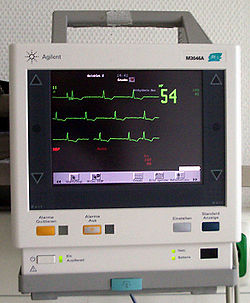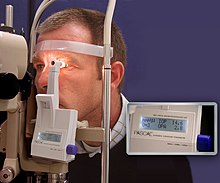Monitoring (medicine)


In medicine, monitoring is the observation of a disease, condition or one or several medical parameters over time.
It can be performed by continuously measuring certain parameters by using a medical monitor (for example, by continuously measuring
Transmitting data from a monitor to a distant monitoring station is known as telemetry or biotelemetry.
Classification by target parameter
Monitoring can be classified by the target of interest, including:
- Swan-Ganz catheter.
- blood flow within the circulatory system. Blood pressure can be measured either invasively through an inserted blood pressure transducerassembly, or noninvasively with an inflatable blood pressure cuff.
- Respiratory monitoring, such as:
- Pulse oximetry which involves measurement of the saturated percentage of oxygen in the blood, referred to as SpO2, and measured by an infrared finger cuff
- Capnography, which involves CO2 measurements, referred to as EtCO2 or end-tidal carbon dioxide concentration. The respiratory rate monitored as such is called AWRR or airway respiratory rate)
- Respiratory rate monitoring through a thoracic transducer belt, an ECG channel or via capnography
- Neurological monitoring, such as of intracranial pressure. Also, there are special patient monitors which incorporate the monitoring of brain waves (electroencephalography), gas anesthetic concentrations, bispectral index (BIS), etc. They are usually incorporated into anesthesia machines. In neurosurgery intensive care units, brain EEG monitors have a larger multichannel capability and can monitor other physiological events, as well.
- Blood glucose monitoring
- Childbirth monitoring
- thermoelectrictransducer.
- Cancer therapy monitoring through circulating tumor cells[1]
Vital parameters
Monitoring of
Medical monitor
A medical monitor or physiological monitor is a medical device used for monitoring. It can consist of one or more sensors, processing components, display devices (which are sometimes in themselves called "monitors"), as well as communication links for displaying or recording the results elsewhere through a monitoring network.[citation needed]
Components
Sensor
Sensors of medical monitors include biosensors and mechanical sensors. For example, photodiode is used in pulse oximetry, Pressure sensor used in Non Invasive bood pressure measurement.
Translating component
The translating component of medical monitors is responsible for converting the signals from the sensors to a format that can be shown on the display device or transferred to an external display or recording device.
Display device
Physiological data are displayed continuously on a
Besides the tracings of physiological parameters along time (X axis), digital medical displays have automated numeric readouts of the peak and/or average parameters displayed on the screen.
Modern medical display devices commonly use digital signal processing (DSP), which has the advantages of miniaturization, portability, and multi-parameter displays that can track many different vital signs at once.[citation needed]
Old
Communication links
Several models of multi-parameter monitors are networkable, i.e., they can send their output to a central ICU monitoring station, where a single staff member can observe and respond to several bedside monitors simultaneously. Ambulatory telemetry can also be achieved by portable, battery-operated models which are carried by the patient and which transmit their data via a wireless data connection.
Digital monitoring has created the possibility, which is being fully developed, of integrating the physiological data from the patient monitoring networks into the emerging hospital
Long-distance connectivity can avail for
Other components
A medical monitor can also have the function to produce an alarm (such as using audible signals) to alert the staff when certain criteria are set, such as when some parameter exceeds of falls the level limits.
Mobile appliances
An entirely new scope is opened with mobile carried monitors, even such in sub-skin carriage. This class of monitors delivers information gathered in body-area networking (
Interpretation of monitored parameters
Monitoring of clinical parameters is primarily intended to detect changes (or absence of changes) in the clinical status of an individual. For example, the parameter of
Change in status versus test variability
When monitoring a clinical parameters, differences between test results (or values of a continuously monitored parameter after a time interval) can reflect either (or both) an actual change in the status of the condition or a
In practice, the possibility that a difference is due to test-retest variability can almost certainly be excluded if the difference is larger than a predefined "critical difference". This "critical difference" (CD) is calculated as:[2]
, where:[2]
- K, is a factor dependent on the preferred probability level. Usually, it is set at 2.77, which reflects a 95% prediction interval, in which case there is less than 5% probability that a test result would become higher or lower than the critical difference by test-retest variability in the absence of other factors.
- CVa is the analytical variation
- CVi is the intra-individual variability
For example, if a patient has a hemoglobin level of 100 g/L, the analytical variation (CVa) is 1.8% and the intra-individual variability CVi is 2.2%, then the critical difference is 8.1 g/L. Thus, for changes of less than 8 g/L since a previous test, the possibility that the change is completely caused by test-retest variability may need to be considered in addition to considering effects of, for example, diseases or treatments.
| Sodium | 3% |
| Potassium | 14% |
| Chloride | 4% |
| Urea | 30% |
| Creatinine | 14% |
| Calcium | 5% |
| Albumin | 8% |
Fasting glucose |
15% |
| Amylase | 30% |
| Carcinoembryonic antigen | 69% |
| C-reactive protein | 43%[3] |
| Glycated hemoglobin | 21% |
| Hemoglobin | 8% |
Erythrocytes |
10% |
Leukocytes |
32% |
Platelets |
25% |
| Unless otherwise specified, then reference for critical values is Fraser 1989[2] | |
Critical differences for other tests include early morning urinary albumin concentration, with a critical difference of 40%.[2]
Delta check
In a clinical laboratory, a delta check is a laboratory quality control method that compares a current test result with previous test results of the same person, and detects whether there is a substantial difference, as can be defined as a critical difference as per previous section, or defined by other pre-defined criteria. If the difference exceeds the pre-defined criteria, the result is reported only after manual confirmation by laboratory personnel, in order to exclude a laboratory error as a cause of the difference.[4] In order to flag samples as deviating from previously, the exact cutoff values are chosen to give a balance between sensitivity and the risk of being overwhelmed by false-positive flags.[5] This balance, in turn, depends on the different kinds of clinical situations where the cutoffs are used, and hence, different cutoffs are often used at different departments even in the same hospital.[5]
Techniques in development
The development of new techniques for monitoring is an advanced and developing field in
As
In many medical problems, drugs offer temporary relief of symptoms while the root of a medical problem remains unknown without enough data of all our biological systems[10] . Our body is equipped with sub-systems for the purpose of maintaining balance and self healing functions. Intervention without sufficient data might damage those healing sub systems.[10] Monitoring medicine fills the gap to prevent diagnosis errors and can assist in future medical research by analyzing all data of many patients.

Examples and applications
The development cycle in medicine is extremely long, up to 20 years, because of the need for U.S. Food and Drug Administration (FDA) approvals, therefore many of monitoring medicine solutions are not available today in conventional medicine.

- Blood glucose monitoring
- diabetes mellitus type 2 .[11]
- Stress monitoring
- Bio sensors may provide warnings when stress levels signs are rising before human can notice it and provide alerts and suggestions.[12] Deep neural network models using photoplethysmography imaging (PPGI) data from mobile cameras can assess stress levels with a high degree of accuracy (86%).[13]
- Serotonin biosensor
- Future serotonin biosensors may assist with mood disorders and depression.[14]
- Continuous blood test based nutrition
- In the field of may provide a continuous results and a computer can provide nutrition suggestions or alerts.
- Psychiatrist-on-a-chip
- In clinical brain sciences drug delivery and in vivo Bio-MEMS based biosensors may assist with preventing and early treatment of mental disorders
- Epilepsy monitoring
- In
- Toxicity monitoring
- Smart biosensors may detect toxic materials such mercury and lead and provide alerts.[16]
See also
- Medical equipment
- Medical test
- MECIF Protocol
- Nanoelectromechanical system(NEMS)
- Functional medicine
- Wireless ambulatory ECG
References
- PMID 20694797.
- ^ PMID 2503170.
- ^ C‐reactive protein (serum, plasma) from The Association for Clinical Biochemistry and Laboratory Medicine. Author: Brona Roberts. Copyrighted 2012
- PMID 22950070.)
{{cite journal}}: CS1 maint: multiple names: authors list (link - ^ American Association for Clinical Chemistry.
- ^ "Healthcare 2030: disease-free life with home monitoring nanomedince". Positivefuturist.com.
- ^ "Nanosensors for Medical Monitoring". Technologyreview.com. Archived from the original on 2012-01-31. Retrieved 2011-08-22.
- ^ "Brain Damage Caused by Neuroleptic Psychiatric Drugs". Mindfreedom.org. 2007-09-15.
- ^ "Medications That Can Cause Nerve Damage". Livestrong.com.
- ^ ISBN 978-1-4165-4971-0.
- PMID 20074337.
- S2CID 902182. Archived from the original(PDF) on 2020-07-30.
- .
- PMID 16106989.
- S2CID 44834010.
- ISBN 978-0-8493-3759-8.
Further reading
- Monitoring Level of Consciousness During Anesthesia & Sedation , Scott D. Kelley, M.D., ISBN 978-0-9740696-0-9
- Healthcare Sensor Networks: Challenges Toward Practical Implementation, Daniel Tze Huei Lai (Editor), Marimuthu Palaniswami (Editor), Rezaul Begg (Editor), ISBN 978-1-4398-2181-7
- Blood Pressure Monitoring in Cardiovascular Medicine and Therapeutics (Contemporary Cardiology), William B. White, ISBN 978-0-89603-840-0
- Physiological Monitoring and Instrument Diagnosis in Perinatal and Neonatal Medicine, Yves W. Brans, William W. Hay Jr, ISBN 978-0-521-41951-2
- Medical Nanotechnology and Nanomedicine (Perspectives in Nanotechnology), Harry F. Tibbals, ISBN 978-1-4398-0874-0
External links
 Media related to Medical monitoring at Wikimedia Commons
Media related to Medical monitoring at Wikimedia Commons

